Exciting New Releases: ZD Toys Collection
Exciting New Releases: ZD Toys Collection

Cyborg Origin, Powers & Media: Complete DC Comics Hero Profile
September 14, 2025 17 min read
When you think of superheroes, you probably picture the godlike might of Superman, the unyielding determination of Batman, or the divine grace of Wonder Woman. But among DC Comics’ pantheon of legends stands a hero unlike any other — a young man who embodies both the triumphs and tragedies of modern science. Victor “Vic” Stone, better known as Cyborg, is more than a collection of cybernetic enhancements; he’s a living symbol of resilience, sacrifice, and the search for identity in a world that often struggles to define what it means to be human.
Introduced in 1980 by the creative powerhouse duo of Marv Wolfman and George Pérez, Cyborg first appeared in DC Comics Presents #26, right before the groundbreaking relaunch of The New Teen Titans. His arrival was perfectly timed — comics were beginning to embrace grittier, more relatable heroes, and Cyborg fit the bill. His origin is as tragic as it is inspiring: a brilliant young athlete, scarred by a horrific accident, saved only by his father’s desperate decision to fuse man with machine. What could have been the end of Vic’s story became his true beginning.
Cyborg isn’t just a superhero with super strength, advanced weaponry, and the ability to interface with technology. At his core, he’s a character defined by duality — the eternal struggle between his human soul and his mechanical body. His stories explore themes of acceptance, belonging, and the price of survival, making him one of the most emotionally layered characters in DC’s roster.
Over the decades, Vic has evolved beyond the pages of comics to become a cultural icon. From his role as a cornerstone of the Teen Titans to his promotion as a Justice League founding member in DC’s modern era, Cyborg has proven his place among the greats. Whether in animation, live-action, or video games, his “Booyah!” battle cry and unwavering courage have resonated with fans around the globe.
When George Pérez sat down to design Cyborg, he wasn’t just sketching metal and circuits—he was building a character who would feel both alien and familiar, mechanical yet deeply human. In interviews, Pérez has spoken openly about how he drew inspiration from existing artists and pop culture in shaping Cyborg’s look and movement.
He has said that the visual spark—especially the half-metal face, the helmet-like plating, the exposed machinery—came largely from Deathlok, a cybernetic hero created by Rich Buckler. The headgear, the metallic half-mask, the contrast between human flesh and cold, gleaming metal—all borrow from that earlier design. But Pérez wanted Cyborg to be more robotic than just an “android.” That meant more visible mechanical limbs, more metal-work showing through, so he would seem less like a person in a robot suit and more like his body was part machine.
Then there’s the question of posture, pose, attitude—the body language. That’s where young Jim Brown enters the picture. Pérez admits he looked at Brown, not just for physical bulk or athleticism (Brown was a famous football player before becoming an actor), but how a powerful human presence carries itself—the swagger, the strength, the way someone moves when they know they can take a hit and keep going. In Cyborg, that translated into a blend: a strong torso, confident stance, tension in the shoulders, but also gestures that betray something still very much human—a vulnerability, a hesitation, a moment of doubt.
What’s fascinating is how these inspirations combine. Deathlok supplies the cybernetic, the half-metal faceplate, the cold robotics; Jim Brown brings motion, attitude, heart. Pérez didn’t just slap metal on a human figure—he merged two worlds. The technical parts aren’t just decorations—they shape how Cyborg moves, how he stands in scenes, how he interacts with environments and people. He isn’t just “metallic”—he’s liminal: always in between what he was and what he’s become.
Pérez’s own upbringing also informed the design. In several interviews, he’s said that growing up in a tough environment gave him a visceral sense of strength, struggle, pride, and always being under pressure—elements that feed into how Cyborg carries himself in the stories: strong, sometimes guarded, but with a heartbeat underneath the plating.
Every reinvention, death, rebirth and legacy of Victor Stone
Creation & First Appearance (1980) — why Vic matters
Victor “Vic” Stone was co-created by Marv Wolfman and George Pérez, and first appeared as Cyborg in DC Comics Presents #26 (October 1980). He was introduced on the cusp of The New Teen Titans relaunch and immediately became one of that book’s emotional cores: a young man literally rebuilt by science, forced to reconcile what was lost with what remained.
Why that matters: Cyborg arrived when comics were increasingly focused on more human, flawed heroes — not just iconography. His origin fused teen drama (family, identity, friends) with speculative tech horror (man rebuilt in pieces), giving writers a long-running emotional engine to drive plots and character development.
Bronze / Early Modern Age: origins, family, and the Teenage years
-
Family & early trauma: Vic is the son of scientists Silas and Elinore Stone. In the early canonical origin, experiments in a lab (usually involving interdimensional research) led to an accident in which Elinore died and Vic was severely injured. Silas used prototype medical/cybernetic technology to save his son — often against Vic’s will — turning him into a half-man, half-machine. This origin provides the core emotional conflict: gratitude versus betrayal.
-
Rebellion and Ron Evers: Before the accident Vic drifted away from lab life — athletic, rebellious, occasionally in trouble thanks to friends like Ron Evers. Those early pages establish Vic’s desire to be “normal” (athlete, friend, boyfriend), which contrasts sharply with his post-accident existence.
-
Public reaction & early ethics: After transformation, Vic experiences social rejection (friends, a girlfriend, public stigma) but retains a moral core — famously rejecting extremist plots even when pressured by old acquaintances. Those scenes are foundational to Cyborg’s ethics: he chooses heroism despite pain and ostracism.
The Teen Titans Era — family of outsiders (1980s–1990s)
-
Finding family with the Titans: Robin (later Nightwing), Starfire, Raven, and Beast Boy become Vic’s surrogate family. The Teen Titans were explicitly written as a support group for “outsiders” and prodigies — an ideal environment for a character wrestling with identity and acceptance. The team lets writers explore both blockbuster battles and small, human moments (friendship, mentorship, romance).
-
Key supporting cast: Sarah Simms (teacher/friend) and Dr. Sarah Charles (S.T.A.R. Labs scientist / love interest in multiple runs) become anchors who humanize Vic and help him physically and emotionally after traumatic arcs.
Technis, Cyberion, and the “becoming a planet” saga — death & assimilation
One of the most bizarre and memorable runs in Vic’s chronology revolves around his mind/body being taken, reconstructed, and—briefly—turned into a planetary construct:
-
Technis and Cyberion: After catastrophic damage (variously a missile crash or other event depending on continuity), Vic’s mind was restored by the alien computer race called the Technis. In return he had to remain connected to them. At one point his identity is subsumed into a larger Technis construct; he is called Cyberion, adopts a more machine-centered outlook, and the Technis build a moon-based construct as their base. This arc has the Titans and the Justice League in moral conflict over whether Victor is salvageable. The Titans ultimately rescue his core consciousness. This storyline is one of the major “loss of humanity / reclamation” tales for the character.
Why it’s pivotal: it pushes the core Cyborg question to the limit — if his mind survives but he’s welded to a machine consciousness, is he still Victor Stone? That arc dramatizes the ethics of restoration, consent, and whether technology can overwrite personhood.
Omegadrome, cloning, and the struggle to remain human
Following Cyberion and Technis, writers explored mechanical bodies, mind transfers, and restoration in inventive ways:
-
Victor’s consciousness is sometimes downloaded into constructs (like the Omegadrome war-suit), and Nightwing later uses a clone to help Victor regain more of his human form. He toggles between more human appearances and powerful armor — a recurring device that lets writers stage “I’m still me” moments and “I’m a machine” power-scenes.
Crossovers, Infinite Crisis and mainstream superhero politics
-
During Infinite Crisis and other major crossovers, Cyborg participates alongside the Titans and sometimes the Justice League, suffering severe damage and being rebuilt. These events often reposition him in the wider DC ecosystem — sometimes as a Titans stalwart, sometimes as a player on the Justice League stage. His technical skills make him valuable in multiversal/tech-centered crises.
The New 52: origin retconned and Justice League founder (2011)

In the 2011 reboot The New 52, Geoff Johns and Jim Lee retooled Cyborg’s origin to tie him into the cosmic mythos of the New Gods:
-
Mother Box origin: Instead of a purely lab accident, the New 52 origin places a Mother Box (technology from New Genesis/Apokolips) at the heart of the accident. That Mother Box merges with Vic’s cybernetics, giving him expanded tech powers — data access to New Gods knowledge, Boom Tube (teleportation) access, and new energy/EMP capabilities. This upgrade was used narratively to put him front and center during the New 52 Justice League formation — in that continuity, Cyborg is presented as one of the founding members of the Justice League alongside Superman, Batman, Wonder Woman, Flash, Green Lantern and Aquaman.
Why this mattered: the change elevated Cyborg from Teen Titans stalwart to one of DC’s flagship heroes, making him more visible across properties — comics, marketing, and adaptations.
Solo series & modern framing — David F. Walker’s 2015 run

-
Cyborg (2015): David F. Walker and artists including Ivan Reis launched an ongoing Cyborg title in July 2015 that leaned into Victor’s interior life: the machine that gives him power is part of him, and sometimes it evolves beyond his control. The series treated him as an established Justice League member but explored what “home” and identity mean when you can’t ever fully turn the suit off. This run reasserted Vic’s status as a lead character worthy of solo titles.
Rebirth, New Justice, Odyssey & Infinite Frontier — versatility and team-ups
-
In subsequent initiatives (DC Rebirth, New Justice, Justice League Odyssey, Infinite Frontier), Cyborg continues as a high-profile character: he fights cosmic threats, investigates the Source Wall/Multiverse mysteries, and repeatedly fronts team books that pair his tech-savviness with more mystical or exploratory premises. These eras keep the character flexible — sometimes a street-level mentor, sometimes a cosmic navigator.
Dawn of DC (2023) & the Detroit return — Morgan Hampton’s take
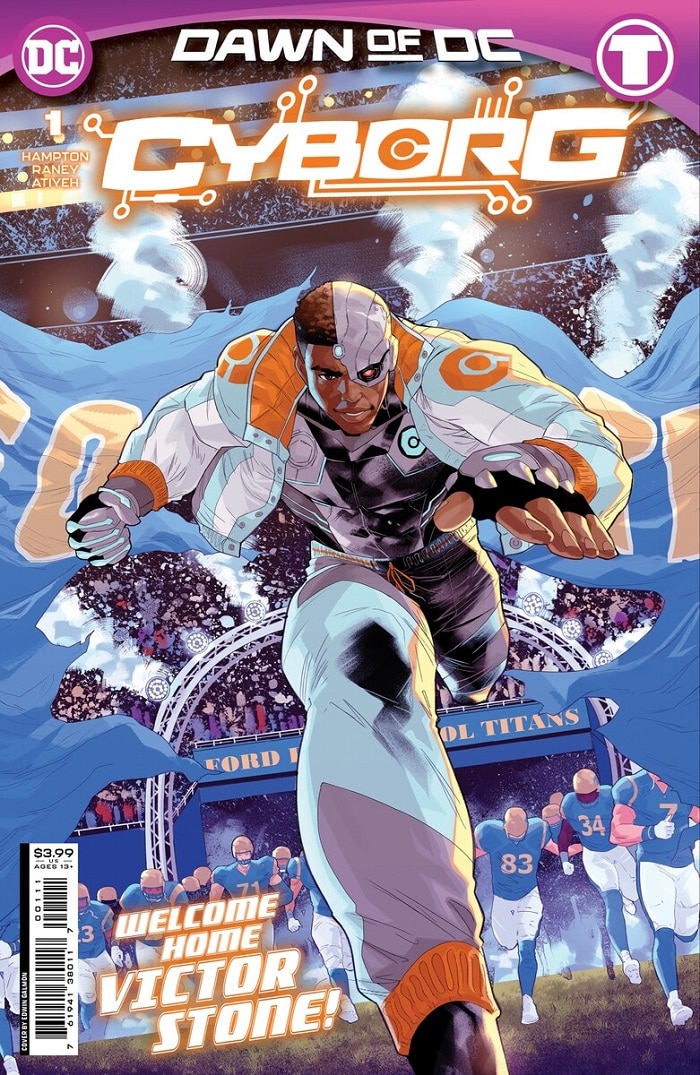
-
Dawn of DC (2023): Morgan Hampton and Tom Raney wrote a six-issue miniseries (and collected trade as Cyborg: Homecoming / Cyborg (2023)) that brings Victor back to his hometown, Detroit, to face an AI threat and unresolved family issues. This run reframes Cyborg as someone seeking simpler, human connections while still being dragged into machine-level dangers — a neat inversion of his early “lab-to-hero” mythos. It’s a modern, grounded entry that connects legacy and present-day social issues.
Key themes across decades — what writers keep returning to
Across every reboot and retcon, these themes recur:
-
Identity vs. augmentation: is Vic the man who died or the machine that functions? Writers use different devices — mind downloads, body cloning, Technis assimilation — to explore the boundary between person and prosthesis.
-
Consent & father/son trauma: the fact that Silas often performs the life-saving surgery without Victor’s informed consent is a recurring source of conflict (love vs. violation).
-
Belonging & found family: the Teen Titans function as the emotional anchor — a chosen family that accepts his parts and his pain.
-
Technology as mirror of society: modern runs explicitly use Vic to probe real-world tech anxieties — surveillance, AI, the cost of “upgrades,” and how we become what our tools make of us. Geoff Johns’s New 52 line even reframed every smartphone user as a kind of cyborg — making Vic a social symbol, not just a metaphor.
Major canonical storylines you can read to trace the arc
If you want a chronological reading list to follow the evolution of the character, start here:
-
DC Comics Presents #26 (1980) — Cyborg’s debut.
-
The New Teen Titans (early issues, 1980s) — formative team stories.
-
Teen Titans Spotlight / DC Special: Cyborg (various specials and spotlight issues) — character-focused deep dives.
-
Technis / Cyberion arcs (New Titans issues that handle his assimilation) — key death/rebirth material.
-
Infinite Crisis / other crossovers — heavy damage and reconstruction arcs.
-
Justice League: Origin (The New 52) — the New 52 re-origin and Justice League founding role.
-
Cyborg (2015) by David F. Walker — modern solo take focusing on identity and tech evolution.
-
Cyborg (2023) / Dawn of DC — Detroit return; human/AI conflict in a contemporary setting.
Adaptations — why Hollywood and animation love Vic
-
Animation: Cyborg is ubiquitous in DC animation (from Super Friends to Teen Titans and Teen Titans Go!). Many fans associate him with the animated “Booyah!” personality and Khary Payton’s iconic voice work.
-
Live-action: He’s been portrayed by Lee Thompson Young (Smallville), Ray Fisher (DCEU films including Zack Snyder’s Justice League), and Joivan Wade (Doom Patrol, Titans). These portrayals amplified his mainstream profile and kept the character in conversation for film/TV adaptations.
The character’s cultural resonance — beyond the comics
Cyborg resonates now more than ever because he’s literally a symbol of our lives: built around technology, pressured to present a curated self, navigating surveillance and identity questions. Different creators have leaned into different readings (a tragic teen, a post-human entity, a team anchor, a tech savant), but the through-line is the same: what makes Victor Stone human isn’t just his flesh — it’s his choices, loyalties, and the heart beneath the hardware.
Powers & Abilities — What Makes Cyborg More Than Metal

Victor Stone, after becoming Cyborg, isn’t just part human, part machine — he’s a living nexus of biology, technology, and evolution. His powers are many, shifting, and often tied to the storyline and writer, but some constants endure.
Core Enhancements
-
Cybernetic Body
A large portion of Victor’s body is replaced with advanced mechanical prosthetics. That word “replace” understates it — in many versions, the metal parts are integrated, not simply grafted on. These limbs, organs, and skeletal reinforcements are often built from metallic alloys (in early stories described as depleted Promethium, titanium, vanadium) that make him far more durable than any flesh-and-blood human. -
Superhuman Strength, Speed, Stamina, Durability, & Flight
Thanks to his cybernetics, Vic can lift weights, move, and react far beyond human limits. He can fly (via jet/repulsor/booster technology) in many incarnations, survive impacts, damage, and blunt trauma that would kill an ordinary person. -
Sensory & Interface Systems
-
His eyes (or one of them) are machine-vision-capable — telescopic, infrared, sometimes even tracking/radar-like.
-
His internal systems can link to computers, hack systems, receive and process data, act like a walking supercomputer. He can manipulate electronics, communicate with machines, sometimes even “absorb” tech.
-
-
Built-in Tools & Weapons
He doesn't just have strength — he has gadgets. Grappling hooks or lines, finger-lasers, sound amplifiers / sonic cannons that can stun or deafen, even shatter rock or deform metal depending on the setting. Early stories also have him using more “conventional” tech-weapons grafted in.
Upgrades, Alien Tech & Mother Box Effects (Post-New 52 and beyond)

Some of Cyborg’s most interesting powers came when writers introduced New Gods tech, especially the Mother Box.
-
With the Mother Box wired into (or fused with) his cybernetics, Vic gets expanded techno-abilities: EMP (electromagnetic pulse) blasts, absorbing or interfacing with more advanced alien tech, adapting to underwater environments, etc.
-
Perhaps most significantly, the ability to open Boom Tubes — teleportation portals used by the New Gods to travel across vast distances or between worlds — becomes part of his arsenal. This gives him not just brute power, but mobility and scale.
-
The idea is that with this tech, his machine parts aren't rigid attachments but more like parts of a living system: adapting, upgrading themselves, connecting to energy redirections, sometimes evolving in response to threats.
Intellect & Tactical Edge
Beyond physical might, Vic Stone remains deeply intelligent:
-
He is often described as having genius-level intellect, with his IQ measured at around 170 in many sources.
-
That intelligence isn’t academic only — he’s a thinker in the field: strategy, problem-solving, quick improvisation, especially when dealing with tech threats, hacking, or investigating alien/other-dimensional dangers.
Weaknesses & Constraints
It’s not all overpowered—in fact, many of Cyborg’s best stories come from how his strengths also bring vulnerabilities:
-
Over-reliance on tech: malfunctioning parts, hacking, viruses, or tech-powered enemies can exploit them.
-
Emotional/psychic vulnerability: stories sometimes show that his human side, his memories, his relationships, are as much at risk as his machine parts.
-
Magic / supernatural threats: since many of his enhancements are scientific or alien tech, magical or mystical forces can bypass/damage what his tech can’t defend well against.
Notable Feats & Examples
-
In the New 52 / later Justice League stories, he confronts Parademon invasions and uses his Mother Box-enhanced capabilities to defend, teleport, even redirect or invert Boom Tubes during attacks.
-
His “sound amplifier / sonic cannon” has been used in comics and animation to produce concussive sound waves strong enough to shatter stone, disorient enemies, knock back armored fighters.
Collected Editions — Cyborg’s Stories You Can Hold in Your Hands
If you want to read Cyborg’s adventures in big chunks — arcs, reboots, emotional beats — these “collected editions” (trade paperbacks, omnibuses, etc.) are the best places to start. They bundle individual issues together so you can see how Vic Stone’s story evolves.
Here are some key collections:
| Era | Title | What’s Collected | Pages | When Pub’d | ISBN |
|---|---|---|---|---|---|
| The New 52 | Unplugged | Cyborg Vol. 1 #1–6 + material from Convergence: Crime Syndicate #2 | 152 | March 29, 2016 | 978-1401261191 |
| The New 52 | Enemy of the State | Cyborg Vol. 1 #7-12 + Cyborg: Rebirth #1 | 168 | December 6, 2016 | 978-1401265311 |
| DC Rebirth | The Imitation of Life | Cyborg Vol. 2 #1–5 + Cyborg: Rebirth #1 | 152 | March 28, 2017 | 978-1401267926 |
| DC Rebirth | Danger in Detroit | Cyborg Vol. 2 #6-13 | 144 | August 15, 2017 | 978-1401270872 |
| DC Rebirth | Singularity | Cyborg Vol. 2 #14-20 | 168 | May 15, 2018 | 978-1401274559 |
| DC Rebirth | (Planned) Vol. 2 #21-26 — solicited, then cancelled | — | — | — | 978-1401285135 |
| Dawn of DC | Homecoming | Cyborg Vol. 3 #1-6 | 144 | April 2, 2024 | 978-1779524843 |
Alternate Versions / What-If / Elseworlds etc.
Beyond the main continuity, there are several alternate-universe takes on Cyborg, which give different “what if” spins. Some examples:
-
In Kingdom Come, there's a variant made of liquid metal, called the third Robotman. He fights with Superman’s Justice League before Batman kills him.
-
In Flashpoint, in the alternate timeline, there’s a Cyborg with a different backstory and role.
-
In DCeased, Cyborg is kidnapped by Darkseid, becomes part of a techno-organic virus thing tied to the Anti-Life Equation, then returns to help survivors and find a cure.
-
In Teen Titans: Earth One, he's bonded with alien metal via experiments by his mother.
These variations show how flexible the character is — writers can strip him down, build him up with different rules, or explore darker/more speculative routes.
What the “Collected Editions” Tell Us — Beyond the Pages
Reading the collected editions reveals more than just story arcs — you can sense how Cyborg’s character, themes, and role in the DC Universe shift over time. Here are some observations and critiques I found, plus responses from fans and critics:
-
Emotional & personal themes get center stage in recent volumes
-
Homecoming (Dawn of DC) especially is praised for being heartfelt. For example, the review “Skin of Metal, Heart of Gold — Reviewing Cyborg: Homecoming” notes that the story gave Vic Stone room to be vulnerable — to explore his relationship with his father, grief, identity, how home has changed.
-
Fans note Homecoming works well because it moves between superhero action and human moments, not favoring spectacle over heart.
-
-
Disability, representation, Black identity — as both strength and burden
-
Cyborg is often seen as one of the few characters who lives at the intersection of several marginalized identities: Black, disabled (or physically altered). Analytical pieces (academic and journalistic) explore how his powers, transformations, and public reactions in stories mirror real-world issues: stigma, acceptance, ableism.
-
One blog post “DC Comics’ Cyborg: Disabled Black Hero with a New Writer” highlights how earlier runs tended to treat his disability as a liability, while newer writers try to shift the narrative so that his prosthetics / cybernetics are part of him, not something to be overcome or pitied.
-
-
Changing continuity & origin tweaks
-
When New 52 and Rebirth reboots happened, many of the old elements (e.g. childhood friendships, parental conflict, his memories) were reshaped: some preserved, some altered. For instance, The Imitation of Life (Rebirth) suggests Victor might not have all of his memories, or that Silas Stone (his father) might have had a hand in erasing or suppressing them.
-
These tweaks sometimes divide fans: people who like origin changes because they bring novelty, and those who miss the older arcs with their emotional clarity.
-
-
Fan reception is mixed but often positive when the story leans into vulnerability
-
Reviews of Rebirth Volume 1: Imitation of Life commend its ambition, but sometimes critique pacing or how much it leans on dialogue and internal conflict over action.
-
Cyborg: Homecoming overall got positive feedback, especially from readers who care about character work and emotional resonance. Some say it’s a welcome return to form.
-
Reception & Legacy — More than Just Metal
Beyond the individual editions, Cyborg holds a special place in comic-book culture, and in representation more broadly. Some threads worth noting:
-
Because Cyborg is Black and “disabled” (or “augmented”), he often makes people in those communities feel seen. His story hasn’t always been perfect, but the repeated return to themes of stigma, identity, being “othered,” and yet choosing heroism and belonging make him deeply meaningful to many.
-
Critics also point out how his visual design (half flesh, half machine) is a powerful metaphor for the intersection of human vulnerabilities and resilience, especially when layered over race and identity.
-
There are also critiques: how sometimes the “disabled” aspect gets used as a device (victimhood, tragedy) rather than a lived reality; or how origin changes / rebooted memories can undercut earlier emotional beats. These criticisms are part of what keeps Cyborg’s storytelling rich — there’s tension between wanting progress & representation and preserving what made people care in the first place.
Television
Live-Action
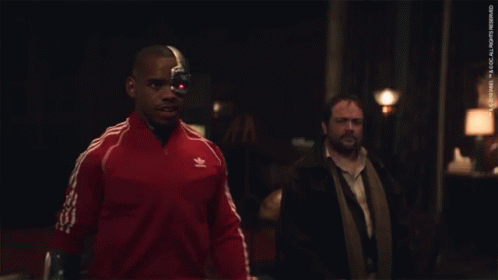
-
Joivan Wade as Cyborg: Joivan Wade portrays Victor Stone, aka Cyborg, in the live-action series Doom Patrol. This version of Cyborg is a former high school football player from Detroit who, after a lab accident that killed his mother, is transformed by his father into the cybernetic hero. Wade's portrayal delves into Cyborg's struggle with his dual identity and his quest for humanity.
-
Crossover with Titans: In a notable crossover event, Cyborg appears in Titans Season 4, marking a significant moment for fans of the Teen Titans universe. This crossover episode, titled "Dude, Where's My Gar?", features Cyborg alongside Beast Boy, bringing together characters from both series
-
Lee Thompson Young in Smallville: Before Wade, Lee Thompson Young portrayed Cyborg in Smallville. His character, Victor Stone, was a former Metropolis High School football player who was presumed dead after a car accident but was secretly rebuilt by scientists with cybernetic enhancements. Young's performance added depth to the character, showcasing Cyborg's internal conflict between his human past and his cybernetic present.
Animation
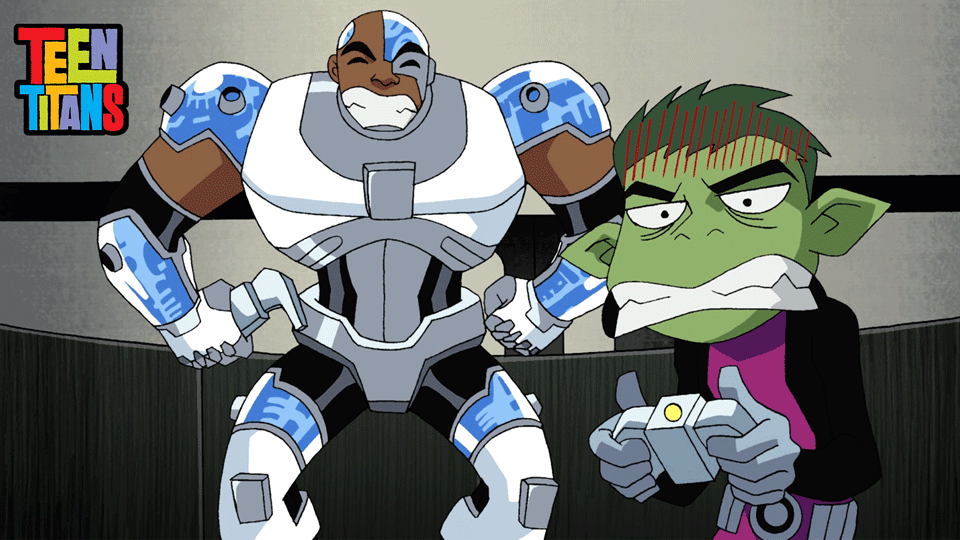
-
Teen Titans (2003): In the animated series Teen Titans, Cyborg is voiced by Khary Payton. This version of Cyborg is known for his humor, love of food, and mechanical prowess. He serves as the team's tech expert and a close friend to the other Titans.

-
Teen Titans Go!: Payton also voices Cyborg in the comedic spin-off Teen Titans Go!, where the character's personality is exaggerated for comedic effect. The series explores lighter, more humorous adventures of the Teen Titans.
-
Justice League Animated Series: Cyborg appears in the animated series Justice League and Justice League Unlimited, voiced by Michael Rosenbaum. In these series, Cyborg is depicted as a member of the Justice League, contributing his technological expertise and combat skills.
Film
-
Teen Titans: Trouble in Tokyo: Cyborg appears in this animated film, voiced by Khary Payton. The movie follows the Teen Titans as they travel to Tokyo to confront a new villain.
-
Justice League Animated Films: Cyborg is featured in several DC Animated Movie Universe films, including Justice League: War, Justice League: Throne of Atlantis, and Justice League Dark: Apokolips War. In these films, he is portrayed as a member of the Justice League, often playing pivotal roles in the team's efforts to combat various threats.
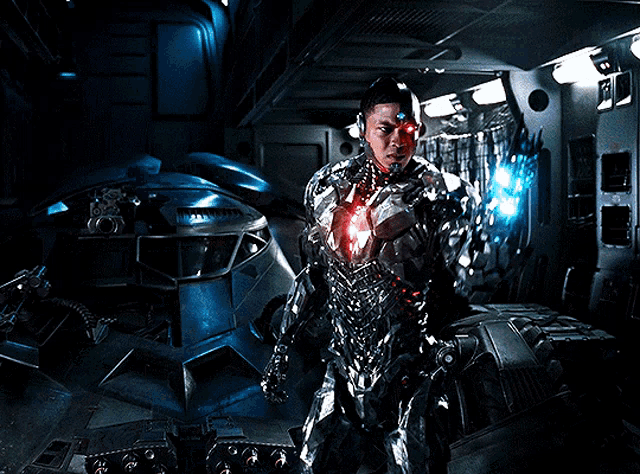
-
DC Extended Universe (DCEU): In the live-action DCEU, Cyborg is portrayed by Ray Fisher. He first appears in Batman v Superman: Dawn of Justice (2016) and is a central character in Justice League (2017) and its director's cut, Zack Snyder's Justice League (2021). Fisher's portrayal explores Cyborg's origins and his integration into the Justice League.
Video Games
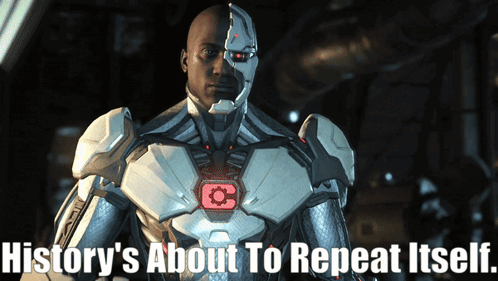
-
Injustice Series: Cyborg is a playable character in the Injustice fighting game series, voiced by Khary Payton. The games feature alternate universe versions of characters and explore darker themes within the DC universe.
-
DC Universe Online: In this MMORPG, Cyborg is a mentor figure for players, guiding them through missions and offering technological support.
![LEGO DC Super-Villains - Cyborg - Open World Free Roam Gameplay (PC HD) [1080p60FPS]](https://i.ytimg.com/vi/dYAyBwUBrH4/maxresdefault.jpg)
-
Lego DC Super-Villains: Cyborg appears as a playable character in this Lego-themed game, where players can create their own villain and team up with various DC heroes.
Cyborg's journey across various media platforms showcases his versatility and enduring popularity. Whether as a member of the Teen Titans, a Justice League hero, or a central figure in animated and live-action adaptations, Cyborg continues to resonate with audiences, offering a compelling blend of humanity and technology.
Cyborg’s journey from comic pages to screen and gaming consoles proves he’s more than just metal and tech—he’s a hero with heart, intellect, and unmatched courage. Fans and collectors, now is the perfect time to grab exclusive DC collectibles at up to 40% OFF. Elevate your collection and celebrate the legacy of one of DC’s most iconic heroes! Click here to avail the offer.
Subscribe
Sign up to get the latest on sales, new releases and more …


